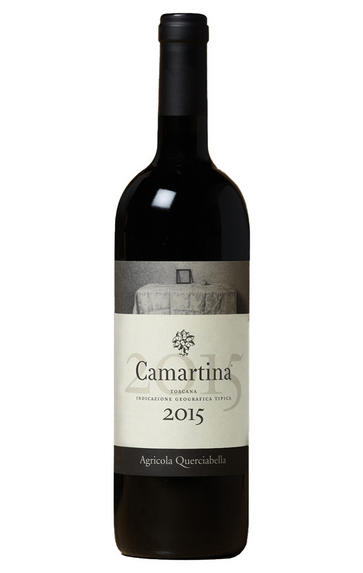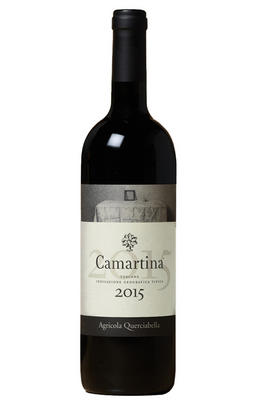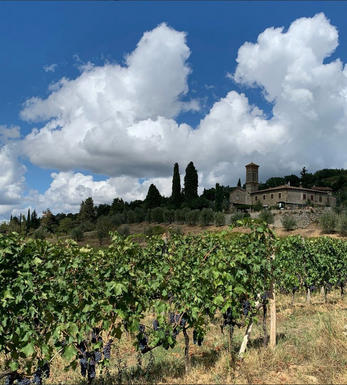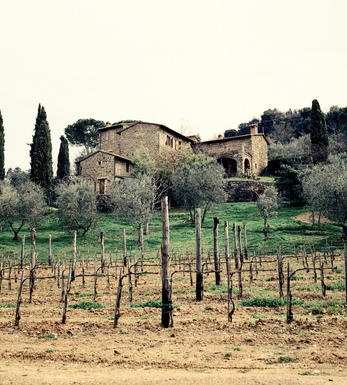
2016 Camartina, Querciabella, Tuscany, Italy

Critics reviews
The 2016 Camartina is superb. As always, Camartina is 70% Cabernet Sauvignon and 30% Sangiovese, all from Greve's Ruffoli district, where Querciabella is located. At this stage in its development, the Camartina is driven by Sangiovese in its red-toned fruit, aromatics and acid profile. The 2016 is vibrant, saline and full of energy. I am so intrigued to see how it develops in bottle.
Drink 2024 - 2041
Antonio Galloni, Vinous.com (August 2020)
70% Cabernet Sauvignon and 30% Sangiovese from the hillside of Ruffoli, near the estate. The vineyard has been certified biodynamic since 2000. Aged for 18 months in barriques of French oak (30% new).
Lustrous youthful ruby. Youthful on the nose too. Concentrated red fruit that is still a little embryonic and not fully unfurled. Just hints of dark, exotic spice notes in the background. Minerally and tight but already shows amazing depth. Gorgeous, taut, tightly knit, tangy fruit and finely ground tannins on the palate. Very long and youthful and superbly structured. Cabernet Sauvignon and Sangiovese blend, of which the sum is greater than the parts. The wine expresses originality rather than grape varieties.
Drink 2024 - 2036
Walter Speller, JancisRobinson.com (November 2020)
Very pretty and precise with tight tannins and polish. It’s linear and compact with blackberry, blackcurrant and cherry character. Racy and polished. From organically grown grapes.
Try after 2023
James Suckling, JamesSuckling.com (July 2021)
About this WINE

Querciabella
The story of Querciabella, or its charming translation ‘beautiful oak’, started in 1974 when oenophile and businessman, Giuseppe (Pepito) Castiglioni brought the estate. The Castiglione family has always pushed boundaries, by planting non-indigenous grape varieties and converting their vineyards to Biodynamic farming.
Since 1981, Camartina has been the estate’s leading Super-Tuscan. Camartina is part of a revolutionary but highly select group of wines, which firmly elevated Italian wine to the world stage. The estate was unhappy with the mediocrity of the Tuscan region, which, in turn, sparked creativity and innovation amongst the best wineries. Querciabella took a risk when producing Camartina, as they eschewed the strict rules of the Chianti Classico region.
Originally, the blend of Camartina favoured Sangiovese but over the years, Cabernet Sauvignon has usurped the traditional, Tuscan grape variety. This is due to the Bordeaux variety acclimatising to Ruffoli’s sandstone slopes. French Oak is the material of choice for the fermentation vessels, creating integrated tannins in the wine. The Sangiovese and Cabernet Sauvignon wines are matured separately for 18 months in French Oak barrels. The leading barrels are selected to make up the final blend.

IGT Tuscany
IGT (Indicazione Geografica Tipica) Tuscany is a wine classification from Italy's Tuscany region. It is one of the official wine classifications recognized by the Italian government. IGT is a step below the highest classification, DOCG (Denominazione di Origine Controllata e Garantita), and above the DOC (Denominazione di Origine Controllata) level.
The IGT classification was introduced in 1992 to allow winemakers more flexibility in grape varieties and employ winemaking techniques while still ensuring a certain level of quality and geographical indication. This classification gives winemakers more freedom to experiment and innovate, deviating from the strict regulations of the DOC and DOCG classifications.
IGT Tuscany wines can be produced throughout the entire region of Tuscany, encompassing various sub-regions and terroirs within the area. This classification allows winemakers to use traditional Tuscan grape varieties, such as Sangiovese, and non-traditional grape varieties, including international ones like Cabernet Sauvignon, Merlot, Syrah, and others.
The IGT Tuscany classification gives winemakers the flexibility to create wines that showcase the unique characteristics of their specific vineyards and winemaking styles. It allows for experimentation with blending different grape varieties, using innovative winemaking techniques, and exploring new regional vineyard sites.
IGT Tuscany wines can vary greatly, from traditional and terroir-driven expressions to more modern and international styles. This classification has played a significant role in developing Super Tuscan wines, often IGT designated and known for their high quality and international recognition.
Overall, IGT Tuscany provides a platform for winemakers in the region to express their creativity and produce wines that reflect their unique vision while maintaining a connection to the rich heritage and traditions of winemaking in Tuscany.

Cabernet Sauvignon Blend
Cabernet Sauvignon lends itself particularly well in blends with Merlot. This is actually the archetypal Bordeaux blend, though in different proportions in the sub-regions and sometimes topped up with Cabernet Franc, Malbec, and Petit Verdot.
In the Médoc and Graves the percentage of Cabernet Sauvignon in the blend can range from 95% (Mouton-Rothschild) to as low as 40%. It is particularly suited to the dry, warm, free- draining, gravel-rich soils and is responsible for the redolent cassis characteristics as well as the depth of colour, tannic structure and pronounced acidity of Médoc wines. However 100% Cabernet Sauvignon wines can be slightly hollow-tasting in the middle palate and Merlot with its generous, fleshy fruit flavours acts as a perfect foil by filling in this cavity.
In St-Emilion and Pomerol, the blends are Merlot dominated as Cabernet Sauvignon can struggle to ripen there - when it is included, it adds structure and body to the wine. Sassicaia is the most famous Bordeaux blend in Italy and has spawned many imitations, whereby the blend is now firmly established in the New World and particularly in California and Australia.


Buying options
Add to wishlist
Description
70% Cabernet Sauvignon and 30% Sangiovese from the hillside of Ruffoli, near the estate. The vineyard has been certified biodynamic since 2000. Aged for 18 months in barriques of French oak (30% new).
Lustrous youthful ruby. Youthful on the nose too. Concentrated red fruit that is still a little embryonic and not fully unfurled. Just hints of dark, exotic spice notes in the background. Minerally and tight but already shows amazing depth. Gorgeous, taut, tightly knit, tangy fruit and finely ground tannins on the palate. Very long and youthful and superbly structured. Cabernet Sauvignon and Sangiovese blend, of which the sum is greater than the parts. The wine expresses originality rather than grape varieties.
Drink 2024 - 2036
Walter Speller, JancisRobinson.com (November 2020)
wine at a glance
Delivery and quality guarantee